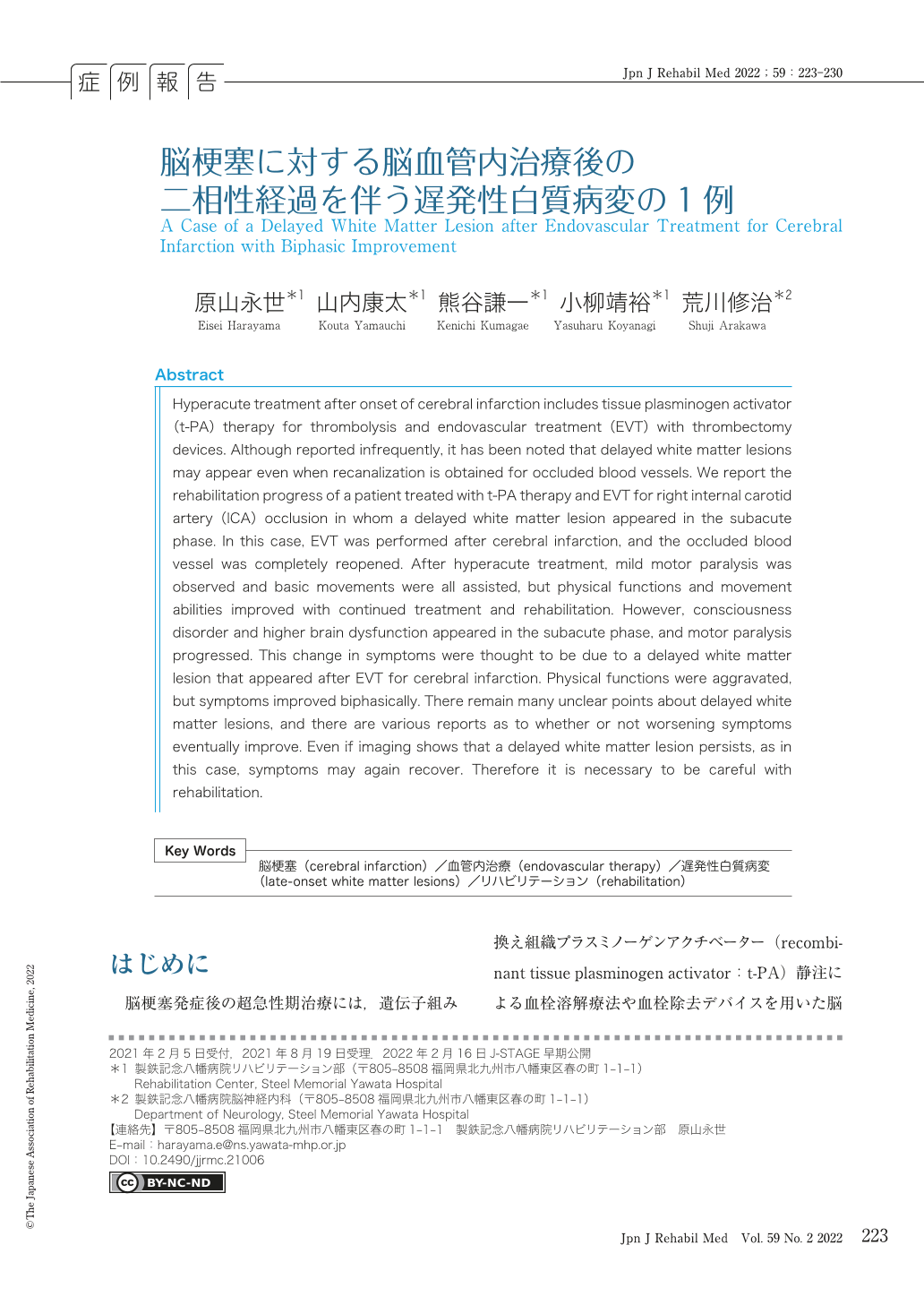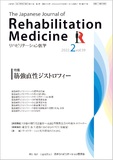Japanese
English
- 販売していません
- Abstract 文献概要
- 1ページ目 Look Inside
- 参考文献 Reference
はじめに
脳梗塞発症後の超急性期治療には,遺伝子組み換え組織プラスミノーゲンアクチベーター(recombinant tissue plasminogen activator:t-PA)静注による血栓溶解療法や血栓除去デバイスを用いた脳血管内治療(endovascular therapy:EVT)がある.t-PA療法は,血栓を溶解することで3カ月後の転帰良好例を有意に増加させる.ECASSⅢ1)の報告から,本邦においてt-PA療法の治療時間は拡大され,発症3〜4.5時間以内にt-PA 0.6mg/kg投与することで3カ月後の転帰良好例は有意に増加した.一方,EVTは2014年のMR CLEAN 2),2015年にはrandomized controlled trial(RCT)3-6)が続いて報告され,治療の有効性が示された.いずれも前方循環系の脳梗塞例を対象としてt-PAにEVTを追加施行することで転帰良好例が増加した.これらの結果から,American Heart Association/American Stroke Association(AHA/ASA)のガイドラインにおいて,EVTが推奨された(class 1,level of evidence A)7).2016年のHERMES 8)では,80歳以上の高齢者であってもEVTの有効性と安全性が示された.
t-PA療法やEVTの進歩に伴い,リハビリテーション治療時には特有な術後合併症を理解し留意しておく必要がある.術後約5%に出現する症候性頭蓋内出血(symptomatic intracerebral hemorrhage:sICH)があり9),十分なリスク管理を行う必要がある.近年,t-PA療法やEVTで良好な再開通を得た場合でも,遅発性白質病変を生じる可能性があることが指摘されているが,リハビリテーションに関連した報告はない.今回,右内頚動脈 (internal carotid artery:ICA) 閉塞に対しt-PA療法とEVTを施行し,亜急性期に遅発性白質病変を呈した症例を経験したため,リハビリテーション治療の経過を報告する.なお,本症例報告の投稿にあたり,対象者には十分な説明を行い書面にて同意を得た.
Hyperacute treatment after onset of cerebral infarction includes tissue plasminogen activator (t-PA) therapy for thrombolysis and endovascular treatment (EVT) with thrombectomy devices. Although reported infrequently, it has been noted that delayed white matter lesions may appear even when recanalization is obtained for occluded blood vessels. We report the rehabilitation progress of a patient treated with t-PA therapy and EVT for right internal carotid artery (ICA) occlusion in whom a delayed white matter lesion appeared in the subacute phase. In this case, EVT was performed after cerebral infarction, and the occluded blood vessel was completely reopened. After hyperacute treatment, mild motor paralysis was observed and basic movements were all assisted, but physical functions and movement abilities improved with continued treatment and rehabilitation. However, consciousness disorder and higher brain dysfunction appeared in the subacute phase, and motor paralysis progressed. This change in symptoms were thought to be due to a delayed white matter lesion that appeared after EVT for cerebral infarction. Physical functions were aggravated, but symptoms improved biphasically. There remain many unclear points about delayed white matter lesions, and there are various reports as to whether or not worsening symptoms eventually improve. Even if imaging shows that a delayed white matter lesion persists, as in this case, symptoms may again recover. Therefore it is necessary to be careful with rehabilitation.

Copyright © 2022, The Japanese Association of Rehabilitation Medicine. All rights reserved.


